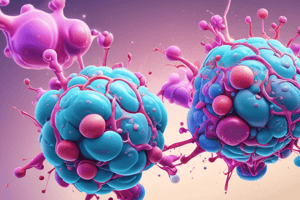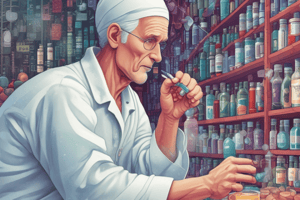Podcast
Questions and Answers
Which property is NOT ideal for an antibiotic?
Which property is NOT ideal for an antibiotic?
- Broad spectrum
- Bacteriostatic action (correct)
- Good tissue distribution
- Selective toxicity
What mechanism do antibacterial drugs primarily target?
What mechanism do antibacterial drugs primarily target?
- Protein synthesis and cell membrane function (correct)
- Cell wall synthesis only
- DNA synthesis only
- RNA replication only
Which of the following antibiotics is a penicillin that can act against penicillinase-producing Staphylococci?
Which of the following antibiotics is a penicillin that can act against penicillinase-producing Staphylococci?
- Methicillin (correct)
- Penicillin G
- Amoxicillin
- Ceftriaxone
Which type of antimicrobial agent is NOT classified under antibacterial agents?
Which type of antimicrobial agent is NOT classified under antibacterial agents?
Which is a characteristic of bacteria that contributes to antibiotic resistance?
Which is a characteristic of bacteria that contributes to antibiotic resistance?
Which class of antibiotics is specifically used mainly in the treatment of MRSA?
Which class of antibiotics is specifically used mainly in the treatment of MRSA?
What is a common mechanism of resistance to β-lactam antibiotics?
What is a common mechanism of resistance to β-lactam antibiotics?
Which generation of cephalosporins is noted for its broadest spectrum of activity against Gram-negative bacteria?
Which generation of cephalosporins is noted for its broadest spectrum of activity against Gram-negative bacteria?
Which antibiotic acts by damaging bacterial DNA and is primarily used in treating urinary tract infections?
Which antibiotic acts by damaging bacterial DNA and is primarily used in treating urinary tract infections?
Which of the following is NOT a 30S inhibitor of protein synthesis?
Which of the following is NOT a 30S inhibitor of protein synthesis?
Flashcards
Antimicrobial Chemotherapy
Antimicrobial Chemotherapy
The use of chemicals to treat infections caused by microorganisms.
Antimicrobial Agents
Antimicrobial Agents
Substances that kill or inhibit the growth of microorganisms, derived from biological sources or chemical synthesis.
Antibiotics
Antibiotics
Antimicrobial agents that work against bacteria; they may be natural or synthetic.
Antiviral Drugs
Antiviral Drugs
Signup and view all the flashcards
Antifungal Drugs
Antifungal Drugs
Signup and view all the flashcards
Antibacterial Mechanism of Action
Antibacterial Mechanism of Action
Signup and view all the flashcards
Selective Toxicity
Selective Toxicity
Signup and view all the flashcards
Bacteriocidal
Bacteriocidal
Signup and view all the flashcards
Bacteriostatic
Bacteriostatic
Signup and view all the flashcards
Beta-Lactams
Beta-Lactams
Signup and view all the flashcards
Penicillins
Penicillins
Signup and view all the flashcards
Cephalosporins
Cephalosporins
Signup and view all the flashcards
1st generation cephalosporins
1st generation cephalosporins
Signup and view all the flashcards
2nd generation cephalosporins
2nd generation cephalosporins
Signup and view all the flashcards
3rd generation cephalosporins
3rd generation cephalosporins
Signup and view all the flashcards
4th generation cephalosporins
4th generation cephalosporins
Signup and view all the flashcards
Glycopeptides
Glycopeptides
Signup and view all the flashcards
Vancomycin
Vancomycin
Signup and view all the flashcards
Aminoglycosides
Aminoglycosides
Signup and view all the flashcards
Protein Synthesis Inhibitors
Protein Synthesis Inhibitors
Signup and view all the flashcards
Mechanism of Resistance
Mechanism of Resistance
Signup and view all the flashcards
Study Notes
Antimicrobial Chemotherapy
- The lecture title is Antimicrobial Chemotherapy
- The instructor is Professor Doctor Mohammed Mahmoud El-Naggar
- Instructor's department: Medical Microbiology and Immunology
- Instructor's official email: [email protected]
- Instructor's mobile phone (optional): 01126625177
- Instructor's academic hours: Sunday 10:00-12:00 AM
- Learning outcomes:
- Describe the mechanism of action of different classes of antimicrobials
- Identify causes and mechanisms of bacterial resistance
- Identify different methods of antibiotic sensitivity
- Topics covered:
- Classification and mechanism of action of antimicrobials on bacteria
- Bacterial resistance to antimicrobials
- Antimicrobial agents:
- Chemical substances derived from biological sources or produced through chemical synthesis
- Kill or inhibit the growth of microorganisms
- Antibiotic: Naturally occurring and synthetically derived organic compounds inhibiting or destroying selective bacteria
Antimicrobial Drugs
- Categorized into:
- Antibacterial drugs (antibiotics)
- Antiviral drugs
- Antifungal drugs
Antibacterial Agents - Mechanism of Action
- Cell wall synthesis:
- Cycloserine
- Vancomycin
- Teicoplanin
- Bacitracin
- Penicillins
- Cephalosporins
- Monobactams
- Cell membrane function:
- Polymyxins
- Protein synthesis:
- Folic acid metabolism inhibitors (Trimethoprim, Sulfonamides)
- 30S inhibitors (Aminoglycosides, Tetracyclines)
- 50S inhibitors (Macrolides, Chloramphenicol)
Cell Wall Inhibitors
- Beta-lactams:
- Penicillins (natural, penicillinase-resistant, extended-spectrum)
- Cephalosporins (1st, 2nd, 3rd, 4th generation)
- Monobactams
- Carbapenems
- Glycopeptides:
- Vancomycin
- Lipoglycopeptide
- Polypeptides
Inhibitors of Protein Synthesis
- 30S inhibitors:
- Aminoglycosides (Gentamicin, Amikacin)
- Tetracyclines (Oxytetracycline)
- 50S inhibitors:
- Macrolides (Erythromycin)
- Chloramphenicol
Inhibitors of Cell Membrane
- Polymyxins
- Cyclic lipopeptides (Daptomycin)
Inhibitors of Nucleic Acid Synthesis
- Sulphonamides
- Act by inhibiting precursor for DNA synthesis
- Trimethoprim, used in Chemoprophylaxis against meningococcal meningitis
- Quinolones
- Target: Topoisomerases (e.g., DNA gyrase)
- Examples: Ciprofloxacin, levofloxacin
- Furanes
- Act by damaging bacterial DNA
- Nitrofurantoin, broad spectrum activity in urinary tract infections
- Rifampicin
- Acts through inhibition of RNA polymerase
- Reserved as antituberculous
Mechanisms of Resistance
- Reduction of intracellular antibiotic accumulation (efflux pump)
- Enzymatic inactivation (β-lactamases)
- Alteration of target site (mutations)
- Alteration of metabolic pathway
Origin of Drug Resistance
- Non-genetic
- Genetic:
- Chromosomal
- Extra chromosomal
Additional Antimicrobial Agents
- Sulphonamides
- Rifampicin
- Cephalosporins
- Aminoglycosides
- Tetracyclines
Studying That Suits You
Use AI to generate personalized quizzes and flashcards to suit your learning preferences.




